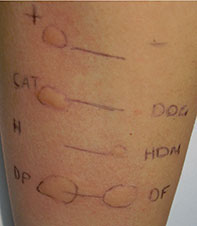Testing for food allergies
It can be hard to tell if a case of hives or an upset stomach is a sign of a food allergy because so many things can cause similar physical discomforts. Even if a particular food is suspected of causing an allergic reaction, how can we tell which one is the culprit?
After all, we usually eat more than one variety of food. Also, the allergic reaction may depend on how the food was prepared or how much of it one eats before a reaction sets in. Family doctors who suspect that symptoms are due to a food allergy may recommend that patients visit an allergist.
Allergists are specially trained doctors who conduct allergy tests and recommend prevention measures. An allergist may do a skin-prick test to determine which foods cause an allergic response. In this test, a series of possible food allergens is applied just under the skin using a small pricking device. The skin area is then observed for the appearance of raised, reddened areas. These will suggest which foods are causing allergic reactions. However, the results of skin tests are not always accurate. Another test that may be required involves taking a small blood sample to test the IgE antibodies to see how they react against various foods.
Another test that can be done by the allergist is called the oral food challenge. In this test, the patient is asked to eat a sample
of food that is suspected of causing an allergic reaction. This is carried out in a medical office where trained professionals are available and ready to promptly treat any allergic reaction. The elimination diet is another way to assess food allergies. Here, patients are asked to follow their usual diet for several days and keep careful records of the foods they eat and any symptoms that occur. One by one, suspected foods are eliminated from the diet.
 If the symptoms continue, the doctor may consider causes other than food allergies.
If the symptoms continue, the doctor may consider causes other than food allergies.
OUTGROWING FOOD ALLERGIES
There is a very good chance that food allergies in young children will go away after a few years. Children who are allergic to wheat, cow’s milk, eggs, or soy usually outgrow it between the ages of 3 and 16 years. However, few children who are allergic to peanuts or tree nuts outgrow their allergies to these foods.
 The best way to tell when someone has outgrown a food allergy is for a physician to conduct a food challenge by having the patient slowly eat a portion of the allergy - causing food. If no allergic response is observed after a few hours, this suggests that the person is no longer allergic to that particular food. Some allergy specialists recommend that persons who outgrow an allergy to peanuts eat them on a regular basis in order to maintain the body’s tolerance to peanuts.
The best way to tell when someone has outgrown a food allergy is for a physician to conduct a food challenge by having the patient slowly eat a portion of the allergy - causing food. If no allergic response is observed after a few hours, this suggests that the person is no longer allergic to that particular food. Some allergy specialists recommend that persons who outgrow an allergy to peanuts eat them on a regular basis in order to maintain the body’s tolerance to peanuts.
###
Terry L. Smith
TERRY L. SMITH is a biostatistician and science writer who
lives in Lawrence, Kansas. She has an M.S. in biometry from the
University of Texas School of Public Health. Smith is the author of
numerous books and articles relating to human health, including
Asthma in Chelsea House’s Genes and Disease series.